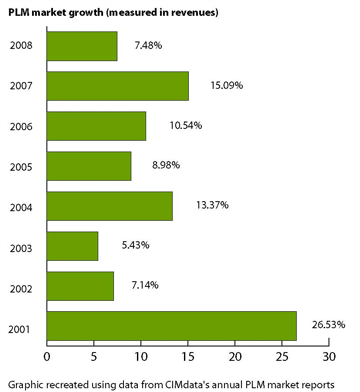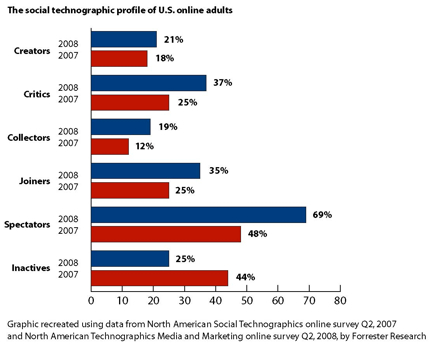Latest News
July 29, 2009

This is the story about two lifecycle management trends: product lifecycle management (PLM) and relationship lifecycle management (social media). But to be more precise, it’s about the importance of relationship management in product lifecycles.
PLM is an offshoot of the need to “[integrate] people, processes, business systems, and information,” according to CIMdata, a market watcher dedicated to PLM study. Sidney Hill, Jr., executive editor for Manufacturing Business Technology, fixed PLM’s birth in the year 1985, crediting American Motors Corp. (later acquired by Chrysler) as the progenitor of the strategic business approach (“How to be a trendsetter: Dassault and IBM PLM customers swap tales from the PLM Front,” May 2003). Going by this date, PLM is now 20-something, an adult.
Nearly everything we now come to associate with social media—blogs (Blogger and Wordpress), social networks (Facebook and MySpace), and user-contributed content (Wikipedia and YouTube)—came into existence about five years ago. Facebook was conceived in 2004 by a group of Harvard computer geeks. It was preceded by MySpace (2003), itself preceded by Friendster (2002). Wikipedia was formerly Nupedia, an expert-written online encyclopedia. It was formally opened to public contribution in 2001. Currently in its 8th year, it is quite possibly the oldest of the social media bunch. Compared to the 24-year-old PLM industry, social media is a baby.
CIMdata’s statistics over the past decade shows PLM growth (measured in revenues) hovering around 7%-15% (in 2001, the beginning of the decade, it peaked at 26.53%). By contrast, social media is growing in leaps and bounds. Josh Bernoff, a Forrester analyst and the author of “The growth of social technology adoption,” wrote in his blog, “Inactives—people untouched by social technologies—have shriveled from 44% down to 25% of the online population. Spectators—those who read, watch, or [consume] social content—have ballooned from 48% to 69%” (“New 2008 Social Technographics data reveals rapid growth in adoption,” October 2008).
Where people go, money follows. In the report titled “Social media playtime is over,” Forrester analyst Jeremiah Owyang predicted, “Despite the recession, more than 50% of marketers will pursue social applications.”
You might choose to sit by the sideline, but you can’t ignore the way social media has irreversibly transformed the way people live, work, learn, play, and collaborate. Here are a few areas where I think PLM should imitate social media:
1. Put people before processes. Somewhere along the way, PLM seems to have reversed its priorities from “people, processes, business systems, and information” to “information, business systems, processes, and people.” The result is a data-cataloging system that forces people to conform to a rigid IT infrastructure. Social media, on the other hand, puts people at the forefront. In a social network, your profile is your greatest asset. Consequently, you put considerable time and effort to develop it with contacts, photo albums, notes, and links. This approach literally puts a face on collaboration.
2. Encourage transparency, not secrecy. The design culture of the past is defined by protectiveness: You don’t let anyone else see what you and your team are working on. But the next wave of designers belongs to a culture of sharing (some might even call it over-sharing): They’ll post online a detailed description of their concept, along with a high-resolution JPEG, in return for constructive feedback from friends, colleagues, even anonymous commentators. To them, file sharing is probably more important than file locking.
3. Email is no longer good enough. For discussions involving more than two, email is a terrible medium. After the third or fourth “reply to all,” an email chain involving six participants or more invariably devolves into an incomprehensible mess. By contrast, social networks like Facebook and Friendster have found ways to organize and display multi-user discussion threads in a digestible fashion. I believe PLM vendors should look to them for collaboration interfaces.
4. Move off the desktop, move into the cloud. Microsoft gets this. The next release of Microsoft Office (2010) will feature browser-based versions of Words, PowerPoint, Excel, and OneNote, which let you work on Web-hosted documents with your colleagues. Computing-intensive 3D modeling tasks should probably still be confined to desktops and workstations, but I don’t see why markups, annotations, approvals, and other change orders can’t be done from a browser. (For more on this topics, read “One small step for office, one giant leap for online collaboration.”)
5. Enable single-click publishing. If I see a link, a blog post, or a photo I like on Facebook, I can republish it elsewhere with a single click. (By the way, feel free to repost this by clicking on the “Share it” button at the bottom.) I think PLM should work the same way. If I’d like to publish the dimensions and material specifications of a gadget I’m designing to an enterprise system, I shouldn’t have to leave my CAD program, launch another program, and manually enter the numeric values, part number, and supplier data into a dialog box. It should be as straightforward as right-clicking on the highlighted dimensions in the CAD model and selecting “Publish to PLM.”
6. Allow personalization. Some of my friends like to add splashes of psychedelic colors to their MySpace background. Others like to publish the result of the latest quiz they’ve taken to their Facebook profile (choices include “What Beatles singer are you?” and “What Star Wars character are you?”). Some prefer to set their privacy settings so only their friends can see their photos. Others set this option to “public” so the whole world could see their Disco-era hairdos. The point is, users should have the option to decide how much or how little exposure they want. By contrast, PLM systems tend to implement the same security features across the board for everyone. Consequently, they sometimes get in the way of ad-hoc collaboration. How can I identify potential collaborators if the system prevents users from volunteering certain details about who they are and what they’ve done? Besides, who better than the user to decide what to reveal and what to conceal?
7. Leave room for interpersonal (nonprofessional) interactions. Creativity, or innovation, usually doesn’t happen in a boardroom (that’s where good ideas go to die). It often comes from a casual conversation unimpeded by fear of judgment or rejection, a serendipitous encounter between two people from different backgrounds (an engineer + a biologist = biomimicry), or a Eureka moment prompted by a natural phenomenon. I can’t think of a PLM system that facilitates this type of interaction. In general, PLM functions as an environment where people talk about projects and portfolios, but nothing else. By contrast, in social media, friendships stemming from playing seemingly silly games like Pillow Fights and Mafia Wars (both available to Facebook users) could lead to individuals from different cultural and professional backgrounds collaborating on a project later on.
People-Ready PLM?In his recent post titled “What I learned: why is implementing PLM hard?,” Jim Brown, president and founder of Tech-Clarity, wrote, “The technical challenges pale compared to the need to change the way people work! ... I believe that PLM is hard not because of technology, but because of people.”
In my view, social media’s rapid penetration has to do with one universal human characteristic: our deep-seated need to connect. Blogs and social networks give us digital platforms to manage, maintain, and enhance our connections with others. They accommodate not just our immediate personal networks but our extended networks and others we have yet to discover. To borrow Microsoft’s marketing lingo, social media was “people-ready” from the start. I’m not sure I can say the same about PLM.
To be people-ready, PLM must conform to how people relate to one another, not the other way around. It needs to give engineers, designers, contractors, and suppliers a low-maintenance framework for managing their complex transactions and relationships. It shouldn’t become an additional IT burden.
The question is not whether people are ready for PLM, but whether PLM is people-ready.
Follow Up: Ken Amann, CIMdata’s director of research, pointed out, “There has been significant seat count growth [in PLM], especially when you count visualization and collaboration seats. There are over 5 million [Siemens PLM Software’s] Teamcenter seats alone. Major growth in seats in all categories has occurred. Social media adoption has exploded for a couple of reasons: (1) the technologies have just been made available and to a wide audience for free —nobody pays for Twitter, etc. (2) PLM is a business-focused issue and is much more complex than IM or chat and has a more limited audience—the entire world doesn’t need PLM but everyone will use chat, Twitter, Facebook, etc.”

Note: This post and the accompanying graphics were updated with additional data from CIMdata on July 29.
Subscribe to our FREE magazine, FREE email newsletters or both!
Latest News
About the Author
Kenneth Wong is Digital Engineering’s resident blogger and senior editor. Email him at [email protected] or share your thoughts on this article at digitaleng.news/facebook.
Follow DE





